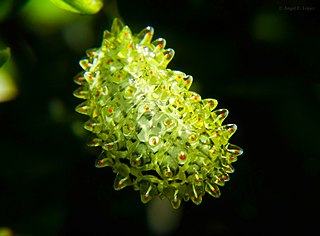Acraga goes is a moth of the family Dalceridae. It is found in Costa Rica, Ecuador, Venezuela, Trinidad, Guyana, Suriname, French Guiana, Colombia, Peru and Brazil. The habitat consists of tropical wet, tropical moist, tropical dry, tropical premontane wet, tropical premontane moist and subtropical dry forests.
Acraga obscura is a moth of the family Dalceridae. It is found in southern Brazil and Uruguay. The habitat consists of warm temperate moist, subtropical wet and subtropical moist forests.
Acraga ria is a moth of the family Dalceridae. It is found in southern Brazil and Peru. Records from Panama represent a misidentification. The habitat consists of subtropical moist forests.

Acraga moorei, the tangerine furry-legs, is a moth of the family Dalceridae. It is found in Venezuela, Colombia, Brazil, Ecuador, Peru, Bolivia, Paraguay and northern Argentina. The habitat consists of tropical wet, tropical moist, tropical premontane wet, tropical premontane moist, tropical lower montane wet, tropical lower montane moist, subtropical wet, subtropical moist, subtropical lower montane moist, subtropical montane wet or rain and warm temperate moist forests.

Acraga coa is a moth of the family Dalceridae. It is found in southern Mexico, Belize, Honduras, Guatemala, El Salvador, Costa Rica and Panama. The habitat consists of tropical wet, tropical moist, tropical premontane wet, tropical premontane rain, tropical lower montane moist, subtropical wet, subtropical moist, subtropical dry and warm temperate wet forests.
Acraga chicana is a moth of the family Dalceridae. It is found in southern Mexico. The habitat consists of subtropical moist forests.
Acraga concolor is a moth from the family Dalceridae. It is found in Venezuela, Suriname, French Guiana, northern Brazil, Ecuador, Peru and Bolivia. The habitat consists of tropical moist, tropical wet, tropical premontane rain, tropical premontane wet and subtropical moist forests.
Acraga citrinopsis is a moth of the family Dalceridae. It is found in Venezuela, Brazil, Peru and Bolivia. The habitat consists of tropical moist, tropical dry, tropical premontane moist, subtropical moist and warm temperate moist or dry forests.
Acraga ferruginea is a moth of the family Dalceridae. It is found in southern Brazil. The habitat consists of subtropical wet and moist forests.
Acraga brunnea is a moth of the family Dalceridae. It is found in southern Brazil. The habitat consists of subtropical moist and subtropical lower montane wet forests.
Acraga boliviana is a moth in the family Dalceridae. It was described by Walter Hopp in 1921. It is found in Bolivia and western Brazil. The habitat consists of subtropical moist forests.
Acraga parana is a moth in the family Dalceridae. It was described by S.E. Miller in 1994. It is found in southern Brazil and Paraguay. The habitat consists of subtropical wet, subtropical moist and warm temperate moist forests.
Dalcerides sofia is a moth in the family Dalceridae. It was described by Harrison Gray Dyar Jr. in 1910. It is found in southern Mexico, Guatemala, El Salvador, Nicaragua and Costa Rica. The habitat consists of tropical moist, tropical dry, tropical premontane wet, subtropical moist, subtropical dry and warm temperate wet forests.
Dalcerides mesoa is a moth in the family Dalceridae. It was described by Herbert Druce in 1887. It is found in southern Mexico, Guatemala, Costa Rica, Panama, Colombia, Venezuela and Ecuador. The habitat consists of tropical wet, tropical moist, tropical dry, tropical premontane wet, tropical premontane rain, subtropical wet and subtropical dry forests.
Dalcerides ingenita is a moth in the family Dalceridae. It was described by Henry Edwards in 1882. It is found in the US from southeastern Arizona, north through the mountains to Flagstaff. It is also found in southwestern Texas and Mexico. The habitat consists of subtropical moist, subtropical dry, warm temperate moist and warm temperate dry forests, as well as warm temperate thorn steppe.
Zikanyrops sparsa is a moth in the family Dalceridae. It was described by Walter Hopp in 1928. It is found in southern Brazil. The habitat consists of subtropical lower montane moist forests.
Dalcerides flavetta is a moth in the family Dalceridae. It was described by Schaus in 1905. It is found in Venezuela, Guyana, Suriname, French Guiana, Colombia, Ecuador, Peru, Bolivia and northern Brazil. The habitat consists of tropical wet, tropical moist, tropical premontane wet, tropical premontane moist, subtropical moist and tropical dry forests.
Paracraga argentea is a moth in the family Dalceridae. It was described by Schaus in 1910. It is found in Mexico, Honduras, Belize, Guatemala, El Salvador, Costa Rica and Panama. The habitat consists of tropical wet, tropical moist, tropical premontane wet, tropical premontane moist, subtropical wet subtropical moist forests.
Paracraga canalicula is a moth in the family Dalceridae. It was described by Paul Dognin in 1910. It is found in Colombia and Peru. The habitat consists of tropical wet, tropical moist and tropical premontane wet forests.
Dalcerides radians is a moth in the family Dalceridae. It was described by Walter Hopp in 1921. It is found in southern Brazil. The habitat consists of subtropical wet, subtropical moist and warm temperate moist forests.

